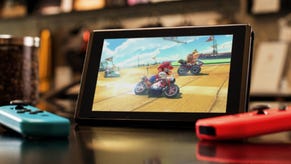Switch OLED model features improved Joy-Con controllers, but drift could still become an issue
Despite improvements made to the Joy-Con controller, Switch users may still experience drift at some point.
With the Switch OLED model, Nintendo has made improvements to the Joy-Con controllers, but analog stick wear and tear is inevitable, which means drift could eventually become a problem.
Many Switch owners have reported since the console’s release that the analog sticks on the Joy-Con controller lose integrity over time, causing a drift issue. Drift is what happens when you move your character in one direction, but it moves in a different direction instead. Basically, the analog stick on the controller deviates, leading to undesirable input.
Nintendo said it has made improvements to the controllers, particularly to the internal parts of the analog sticks. The company said it has been making improvements to the controllers continuously since the console launched and incorporated these changes into the Joy-Con controllers included with the console, Nintendo Switch Lite, and the controllers sold individually.
There are two theories as to the cause of drift: dust or some sort of filth accumulating under the rubber cap designed to keep the controller's interior clean; or worn-down contacts. There is no clear-cut answer though, as Nintendo has never openly discussed the problem which would provide an answer as to why drift occurs in the first place.
Improvements were made to the internal components of the Joy-Con, and the company uses the new versions of the parts when the controllers are repaired. Also, similar continual improvements have been made for the Nintendo Switch Pro Controller.
“Joy-Con controllers have lots of different features, so we’ve been continuing to make improvements that may not always be visible,” said Toru Yamashita Deputy GM of Nintendo’s Technology Development Department.
“Among others, the analog-stick parts have continuously been improved since launch, and we are still working on improvements. The analog stick at first release cleared the Nintendo reliability test using the method of rotating the stick while continually applying a load to it, with the same criteria as the Wii U GamePad’s analog stick.
“As we have always been trying to improve it as well, we have investigated the Joy-Con controllers used by the customers and repeatedly improved the wear resistance and durability.”
Because parts of the Joy-Con analog sticks are specifically designed and cannot be bought off the shelf, Nintendo has had to undergo considerations to improve them. This led to changes in the reliability test itself, and the company continues to make changes to improve durability and clear new tests.
Still, there is an issue with wear and tear when it comes to the analog sticks on the Joy-Con controller, and it is something Nintendo is “continuously tackling.”
“The degree of wear depends on factors like the combination of the materials and forms, so we continue to make improvements by researching which combinations are less likely to wear,” Yamashita said.
“The Joy-Con controller specifications hadn’t changed in the sense that we didn’t add new features such as new buttons, but the analog sticks in the Joy-Con controllers included with Nintendo Switch – OLED Model are the latest version with all the improvements.
“Needless to say, so are the analog sticks included in Nintendo Switch, Nintendo Switch Lite, separately sold Joy-Con controllers and the Nintendo Switch Pro Controller that are currently being shipped.”
Hopefully, with the new and improved parts this will mean fewer instances of drift for players, but, the issue could still rear its ugly head as the analog sticks’ internal components wear out over time.








_XeCLKxB.png?width=291&height=164&fit=crop&quality=80&format=jpg&auto=webp)
